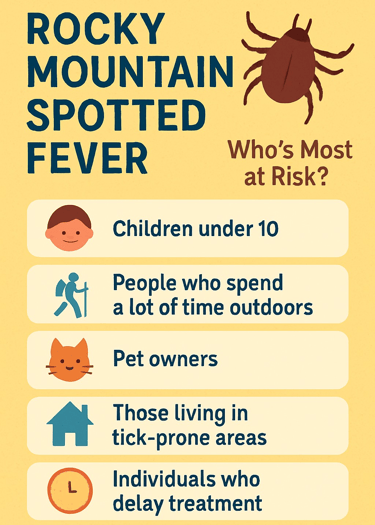Stay updated on what is trending in health. Discover tips and resources for a healthier, balanced life.
Rocky Mountain Spotted Fever: A Dangerous Tick-Borne Disease
Learn the symptoms, treatment, and prevention tips for Rocky Mountain Spotted Fever (RMSF) —a serious and dangerous tick-borne illness that requires quick action.
DISEASES AND CONDITIONS
Dr. S. Ali
8/23/20255 min read


Rocky Mountain Spotted Fever (RMSF) is a rare but potentially life-threatening illness caused by the Rickettsia rickettsii bacteria. Transmitted by the bite of an infected tick, it can escalate quickly—so early detection and treatment are key.
If you spend time outdoors or live in an area where ticks are common, it’s worth knowing the signs, risks, and how to protect yourself.
What Is Rocky Mountain Spotted Fever?
Rocky Mountain Spotted Fever (RMSF) got its name because it was first identified in the early 1900s in the Rocky Mountain region of the United States. Scientists initially believed it was limited to that area. However, over time, cases have been found across the U.S., especially in the Southeast.
Despite the name, Rocky Mountain Spotted Fever is not confined to the Rocky Mountains—it's now more common in states like North Carolina, Oklahoma, Arkansas, Tennessee, and Missouri. Cases also occur in parts of Canada, Mexico, and Central and South America.
So, the name reflects its historical discovery, not its current geographic range.
How Does It Spread?
The disease is spread mainly by:
American dog ticks
Rocky Mountain wood ticks
Brown dog ticks (especially in the southwestern U.S. and Mexico)
Once bitten by an infected tick, the bacteria can enter your bloodstream and begin damaging the lining of blood vessels, leading to serious complications if untreated.
How will you know if a tick bites?
You may not always know if a tick has bitten you.
Ticks are small—some as tiny as a poppy seed—and their bite is usually painless. That means they can attach and feed for hours (or even days) without you feeling a thing.
Here’s how you might know or suspect a tick bite:
Signs You May Have Been Bitten by a Tick
A small, red bump
This might look like a mosquito bite. In some cases, you’ll see a flat or slightly raised spot where the tick latched on.A tick still attached
You may find the tick embedded in your skin during a shower or while changing clothes. They prefer warm, hidden areas like your scalp, armpits, behind the ears, groin, or behind the knees.Itching or irritation
Some people feel mild itchiness or notice tenderness at the bite site after the tick falls off.A scab or dark spot
Once a tick detaches or is removed, it can leave a small scab that you might mistake for a pimple or mole.
What If You Never Saw the Tick?
That's common. Many people with RMSF or Lyme disease never recall a tick bite. That’s why it’s crucial to:
Do full-body tick checks after being outdoors—especially if you were in grassy, wooded, or brushy areas.
Look carefully in hidden spots like the scalp, waistband, sock line, and underarms.
Check pets too! Dogs can bring ticks into your home.
Early Symptoms to Watch For
Symptoms usually appear within 2 to 14 days after a tick bite. They often start mild but can become severe very quickly.
Common early signs include:
Fever and chills – One of the first signs of RMSF, often sudden and high.
Severe headache – Not your average headache; it’s usually intense and persistent.
Muscle aches and fatigue – You may feel weak and achy all over.
Nausea and vomiting – Especially in children, this may be one of the first symptoms.
Loss of appetite – Feeling sick and unable to eat.
Stomach pain – Sometimes confused with appendicitis.
What About the Rash?
One of the classic features of RMSF is a spotted rash, but it doesn’t always show up right away—and some people may not get it at all.
If it appears, the rash:
Often begins 2–5 days after fever starts
May start on wrists, ankles, or palms and soles
Spreads toward the trunk
Can look like small, flat pink spots or red splotches
May become purplish in severe cases (a sign of bleeding under the skin)
Important: Waiting for a rash before seeking help can delay treatment and increase risk.
How Serious Is It?
Rocky Mountain Spotted Fever is a medical emergency.
If not diagnosed and treated promptly, it can lead to severe complications, including:
Organ failure
The infection can affect vital organs like the kidneys, liver, and heart, causing them to shut down. This can become life-threatening without urgent medical care.Bleeding problems
RMSF can damage blood vessels, leading to internal bleeding, easy bruising, or bleeding under the skin. In severe cases, it may resemble a hemorrhagic fever.Brain swelling (encephalitis)
The bacteria can inflame the brain, causing confusion, seizures, or coma. This is especially dangerous and can lead to long-term neurological issues.Permanent damage
Even with treatment, some people are left with lasting complications like hearing loss, cognitive difficulties, or damaged blood vessels, especially if treatment was delayed.Death—especially in children
RMSF can be fatal if not treated early, and children under 10 are particularly vulnerable to severe outcomes. Early diagnosis and antibiotics are critical to survival.
But here’s the good news: With prompt antibiotics, most people recover fully.
How Is Rocky Mountain Spotted Fever Treated?
The first-line treatment is an antibiotic called doxycycline, and it works best when started early—ideally within the first 5 days of symptoms.
Professional Tip: If your doctor suspects RMSF, they may start treatment before confirming it with a test. Waiting for test results can be dangerous.
How Can You Prevent Rocky Mountain Spotted Fever?
The best defense is to prevent tick bites:
Use insect repellent – Look for one with DEET or permethrin (clothing only).
Wear long sleeves and pants – Especially in grassy or wooded areas.
Tuck pants into socks – Not fashionable, but effective.
Do tick checks – Especially after hikes or outdoor play.
Shower after outdoor activities – To wash away any unattached ticks.
Check pets – Dogs can bring ticks into your home.
If you find a tick:
Use fine-tipped tweezers to remove it
Grab as close to the skin as possible and pull steadily
Clean the bite area with soap and water
Monitor for symptoms over the next two weeks
Who’s Most at Risk for Rocky Mountain Spotted Fever?
Anyone who gets bitten by a tick carrying the Rickettsia rickettsii bacteria can develop RMSF—but some people are more likely to be exposed or develop serious complications. Here's a closer look at the higher-risk groups:
Children Under 10
Young children are more vulnerable for several reasons. They tend to play in grassy or wooded areas, are less likely to notice or remove ticks promptly, and may not be able to describe early symptoms like headaches or muscle pain. RMSF can also progress more rapidly and severely in children.
People Who Spend a Lot of Time Outdoors
Hikers, campers, farmers, gardeners, and outdoor workers (like landscapers or park rangers) are at greater risk simply because they spend more time in tick habitats. Ticks thrive in areas with tall grass, leaf litter, and shrubs—and they can latch on without you even noticing.
Pet Owners
Ticks can hitch a ride indoors on pets—especially dogs—and then transfer to humans. If your pets go outside, check them regularly and use tick preventives recommended by your vet.
Those Living in Tick-Prone Areas
Rocky Mountain Spotted Fever isn’t just found in the Rocky Mountains. It’s most common in the Southeastern and South Central U.S., including states like North Carolina, Arkansas, Oklahoma, and Tennessee. People living or vacationing in these regions are at increased risk.
Individuals Who Delay Treatment
Early treatment with antibiotics is critical. Delays can lead to serious complications like organ failure, brain swelling, and even death. People who ignore early symptoms—like fever, rash, or headache—may unknowingly allow the disease to progress.
Final Thoughts
Rocky Mountain Spotted Fever may be rare, but it's not something to take lightly. Know the signs, act fast, and take prevention seriously—especially if you live in or travel to tick-prone areas.
Being tick-smart can literally save your life
Sources:
Centers for Disease Control and Prevention (CDC)
https://www.cdc.gov/rmsf/index.htmlMayo Clinic
https://www.mayoclinic.org/diseases-conditions/rocky-mountain-spotted-fever/MedlinePlus
https://medlineplus.gov/ency/article/000654.htmWorld Health Organization
https://www.who.int/news-room/fact-sheets/detail/rickettsial-diseases
Pulse Your Health
Empowering you to achieve your health goals.
Contact
© 2025. All rights reserved.
Disclaimer: The content on this website is for informational purposes only and is not medical advice. Always seek the advice of your physician or other suitably qualified healthcare professional for diagnosis, treatment and your health related needs.
